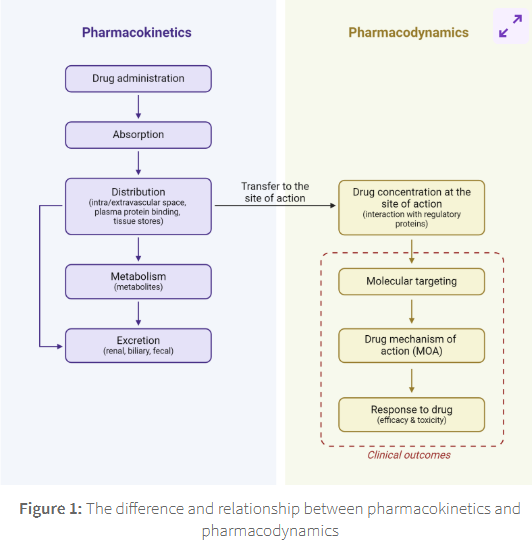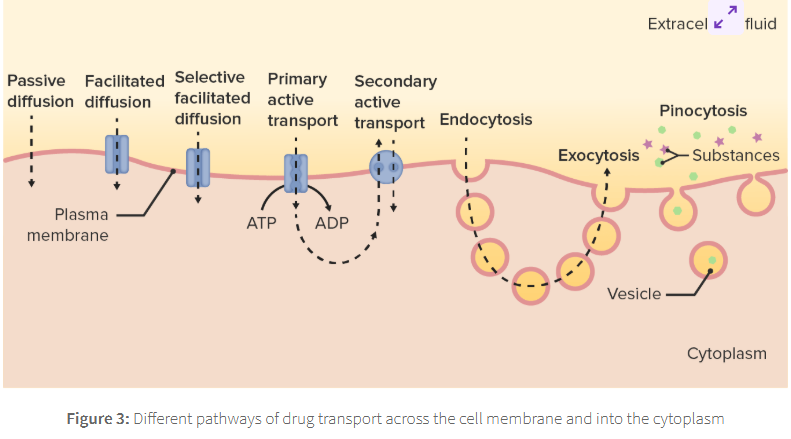11.0 pharmacokinetics
1/21
There's no tags or description
Looks like no tags are added yet.
Name | Mastery | Learn | Test | Matching | Spaced |
|---|
No study sessions yet.
22 Terms
pjarmacokinetics PK
the study of how the interplay between the body and the administred substance for the entire time of exposure
pharmacodynamics PD
the study of the biochemical and physiological effects of drugs
Both pharmacokinetics (PK) and pharmacodynamics (PD) play an important role in how administered substances
(in our instance, pharmaceutically active compounds) react within the body.
We compartmentalise these actions as either PK, which can be thought of as the drug's journey through the body
and PD, which can be thought of the drug's effect on the body (See Figure 1 below).

As a drug journeys through the body, it passes through four different phases of pharmacokinetics
absorption,
distribution,
metabolism,
and excretion (ADME):
absorption
How the drug moves from the site of administration to the site of action.
distribution
The journey of the drug through the bloodstream to various tissues of the body.
metabolism
The process(es) that break down the drug.
excretion
The removal of the drug from the body.
Absorption is the movement of a drug from its site of administration to the bloodstream. The rate of absorption is dependent on:
Route of administration
The formulation
The chemical properties of a drug
Drug-food interactions
The type of administration (e.g., oral, intravenous, inhalation) of a drug influences its bioavailability,
i.e. the fraction of active form that enters the bloodstream and successfully reaches its target site.
. For example, if a drug is given intravenously, we by-pass absorption resulting in 100% bioavailability is we have an immediate delivery into the systemic circulation.
However, orally administered medications have incomplete absorption and result in less drug delivery to the site of action. When considering orally administered drugs we need to review:
The differences in pH observed throughout the GI tract
differing pH will regulate the degree of ionisation of a drug, where un-ionised forms are generally lipophilic, which are more amenable to crossing the cell membrane
The changes in surface area along the GI tract -
the small intestine present with a very large surface area sue to the presence of microvilli, meaning that the majority of absorption occurs in the small intestine.
The degree of blood perfusion
we must consider not only the degree of perfusion at the site of administration, but also other external pressures that may effect blood flow, such as shock.
Presence of other materials in the GI
Levels of GI products such as bile and mucus will effect absorption rates. For example, the thick mucus layer observed in the stomach will limit the rate of drug absorption. Also consider external products such as food and drink which may hinder or enhance the absorption rate.
Ongoing chemical reactions
chemical reactions native to the GI tract can either enhance or hinder absorption. For example the hydrolysis reactions occurring by gastric acid and digestive enzymes and metabolism by gastric flora
Transit times
Changes to transit times in the GI tract due to disease or side-effects can hinder absorption. For example rapid transit, such as in diarrhoea, and delayed gastric emptying, which increases exposure time to hydrolysis.
Pinocytosis:
Also requiring energy expenditure, pinocytosis is when fluid or particles are engulfed by the cell in the form of vesicles.
Here, the cell membrane invaginates around a drug molecule, incorporating it into the cell within a small vacuole.
The vacuole may then be released into the cell or extruded out of the other side of the cell.
This mechanism is thought to be of importance in the transport of large molecules such as insulin.
